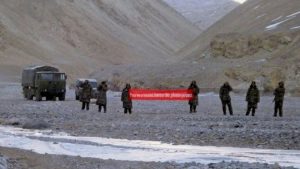 Janjivan Bureau / NEW DELHI : Bhutan welcomed moves by India and China to withdraw troops from a strategic area which it claims as its territory, ending a months-long military stand-off between its giant neighbours.
Janjivan Bureau / NEW DELHI : Bhutan welcomed moves by India and China to withdraw troops from a strategic area which it claims as its territory, ending a months-long military stand-off between its giant neighbours.
The tiny Himalayan country of fewer than a million people had been caught in the middle of what some analysts called the worst crisis in India-China relations in decades.
The row centred on the Doklam plateau, an area high in the Himalayas that is claimed by both China and Bhutan.
India itself does not claim the territory but has a military presence in Bhutan, a close ally.
It stepped in to prevent Chinese border guards from building a road there, prompting Beijing to accuse it of trespassing on Chinese soil.
“Bhutan welcomes the disengagement by the two sides at the face-off site in the Doklam area,” its foreign ministry said.
“We hope this contributes to the maintenance of peace and tranquillity and status quo along the borders of Bhutan, China and India, in keeping with existing agreements between the respective countries.”
The Doklam plateau is strategically significant as it gives China access to the so-called “chicken’s neck” – a thin strip of land connecting India’s north-eastern states with the rest of the country.
For weeks, worries had been growing of a major conflict between the two nations until both sides agreed on Monday to give some ground in order to end the stand-off, although neither country has offered explicit details of the terms of disengagement. Some analysts said that India realised, after initially talking tough and sending troops into the area, that it was overmatched, economically and militarily.
“What we are seeing is face-saving,” said Mr C. Raja Mohan, director of Carnegie India, a branch of the Carnegie Endowment for International Peace.
China clearly too, analysts said, had its own sound reasons to end the dispute.
“It would be a strategic disaster for China to make a mortal enemy out of India,” said Asian and international studies professor Daniel Lynch at the City University of Hong Kong.
“The last thing an ageing, economically less vibrant China needs is to fall into a generations-long cold war with India,” he added.
When asked whether China had now stopped building the road in Doklam, known in China as Donglang, Chinese Foreign Ministry spokesman Hua Chunying said China had, for a long time, been building roads and other infrastructure there for border protection and to help local people’s livelihoods.
“We will make an overall assessment of the weather conditions and all related factors, and according to the actual circumstances complete construction plans,” Ms Hua told a daily news briefing in Beijing yesterday, without elaborating.
She reiterated that Chinese border troops were continuing their patrols in the area. While vowing that China would “protect territorial sovereignty”, Ms Hua added that “the Chinese government values the development of good neighbour relations with India”.
India’s Prime Minister Narendra Modi is scheduled to visit China next week for an international conference, which may have placed pressure on Chinese and Indian officials to find a solution before he arrives.
Still, some experts warned that relief could be temporary.
“Another stand-off is completely possible,” said India expert Zhang Li at Sichuan University in southwest China. “We shouldn’t be overly optimistic.”
Chinese FM hopes India to learn lessons from recently resolved border standoff
Chinese Foreign Minister Wang Yi has expressed hope that India will learn lessons from a recently resolved border standoff between the two countries and avoid such occurrences in the future.
He was speaking in Beijing after the two countries agreed to pull back their troops from the common border.
Earlier, Chinese Foreign Office spokeswoman had stated that Beijing would complete building of roads and other infrastructure along the Himalayan border with India for border protection and to help local people’s livelihoods.
She said that its border troops will also continue their patrols in the Doklam area.

















